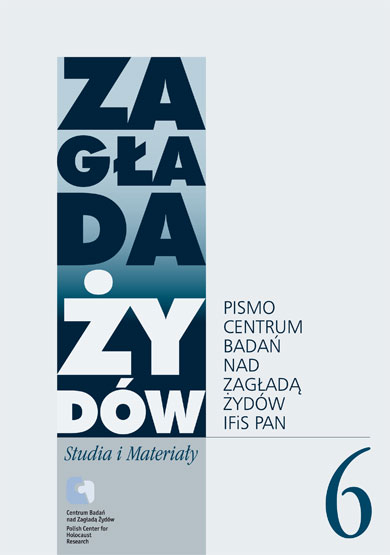Lagry w perspektywie genderowej
Zagłada Żydów. Studia i Materiały, Nr 6 (2010), Strony: 193-204
Data zgłoszenia: 2020-12-06Data publikacji: 2010-12-30
 https://doi.org/10.32927/zzsim.716
https://doi.org/10.32927/zzsim.716
Abstrakt
The questions of corporality, sexuality, women’s experience and their record examined in the context of camp issues and the Holocaust have only recently become the subject of attention. Gender studies play a significant role in the discussion on those issues. Existing works on the subject (i.a. the book of Bożena Karwowska Ciało. Seksualność. Obozy zagłady [Gender, Sexuality, Concentration Camps]) show that the tools of gender studies are cognitively useful, but, as it appears, their role of being particularly predestined to uncover what is marginalized or condemned to silence is overestimated. Nevertheless, apart from the dominance of the patriarchal discourse, there have always existed other reasons for suppressing the matter of corporality and sexuality both in works on KL’s and in science; social taboo (controlled not only by the male symbolical order) as well as the policy (e.g. it was possible to
write openly about rape on former female prisoners by Soviet soldiers only after censorship had been lifted) play an important role here. The fundamental value of the gender perspective lies in the firm approach towards the issues hitherto marginalized in the KL context – both by science and, to a lesser extent, literature (which is reflected by i.a. works of Pankowski and Posmysz published years ago).
Licencja
Prawa autorskie (c) 2010 Autor&"Zagłada Żydów. Studia i Materiały"

Utwór dostępny jest na licencji Creative Commons Uznanie autorstwa 4.0 Międzynarodowe.
https://creativecommons.org/licenses/by/4.0
Czasopismo publikowane jest w standardzie Diamond Open Access na licencji CC-BY-4.0 Deed - Uznanie autorstwa 4.0 Międzynarodowa - Creative Commons
Podobne artykuły
- Dariusz Libionka, Barbara Engelking, Anki Grupińskiej zapisywanie żydowskich opowieści (12 opowieści żydowskich); Odczytanie listy. Opowieści o warszawskich powstańcach Żydowskiej Organizacji Bojowej , Zagłada Żydów. Studia i Materiały: Nr 10 (2014)
- Dariusz Libionka, Robert Kuwałek in memoriam , Zagłada Żydów. Studia i Materiały: Nr 10 (2014)
- Dariusz Libionka, David Silberklang, Gates of Tears: The Holocaust in the Lublin District , Zagłada Żydów. Studia i Materiały: Nr 11 (2015)
- Dariusz Libionka, W poszukiwaniu miliona Sprawiedliwych , Zagłada Żydów. Studia i Materiały: Nr 11 (2015)
- Dariusz Libionka, Walka i propaganda. Powstanie w getcie warszawskim z perspektywy polskiego Londynu , Zagłada Żydów. Studia i Materiały: Nr 10 (2014)
- Dariusz Libionka, Jan Grabowski, Meldunki Obwodu „Praga” Policji Polskiej o zatrzymaniach Żydów w Warszawie w okresie maj–lipiec 1943 r. , Zagłada Żydów. Studia i Materiały: Nr 10 (2014)
- Nawojka Cieślińska-Lobkowicz, O wystawie „Czego nie mogliśmy wykrzyczeć światu” w Żydowskim Instytucie Historycznym w Warszawie , Zagłada Żydów. Studia i Materiały: Nr 14 (2018)
- Joanna Tokarska-Bakir, Odpowiedź na recenzje Bożeny Szaynok i Marcina Zaremby , Zagłada Żydów. Studia i Materiały: Nr 14 (2018)
- Dariusz Libionka, Encyclopedia of Camps and Ghettos 1933–1945, t. 2: Ghettos in German-Occupied Eastern Europe , Zagłada Żydów. Studia i Materiały: Nr 9 (2013)
- Aleksandra Ubertowska, Berel Lang, Nazistowskie ludobójstwo. Akt i idea , Zagłada Żydów. Studia i Materiały: Nr 3 (2007)
<< < 1 2 3 4 5 6 7 8 9 10 11 12 13 14 15 16 17 18 19 20 21 22 23 24 25 > >>
Możesz również Rozpocznij zaawansowane wyszukiwanie podobieństw dla tego artykułu.
 English
English
 Język Polski
Język Polski




